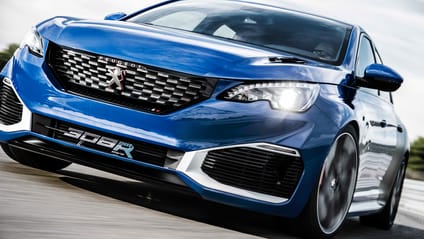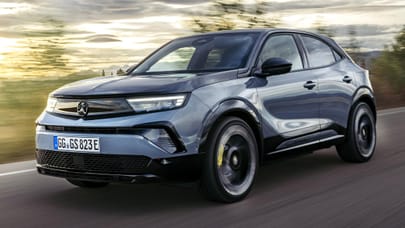
Top Gear drives the 494bhp Peugeot 308 R Hybrid
0–62mph in four seconds... and 94mpg: we drive the world’s first white-hot-hatch


The French are rather talented at turning out a hot hatchback. You surely already know that. Equally, you must be familiar with the very best examples – 205 GTI, Clio Cup, 306 Rallye – and how they trade off pure simplicity. Small cars with an oversized engine, and naff-all weight for it to haul.
This Peugeot 308 R Hybrid would appear cut from the same cloth, making just shy of 500bhp and topping 62mph in four seconds. GT3 RS power in a sensible hatchback ought to be the dictionary definition of ‘overengined’.
Photography: Lee Brimble
This feature was originally published in the January 2016 issue of Top Gear magazine.
Advertisement - Page continues below
But the truth is rather more complex: this is only a 494bhp all-wheel-drive hatchback part of the time. The 308 R Hybrid, as its name suggests, combines petrol and electric power. The 268bhp 1.6 petrol turbo from the 308 GTI powers the front axle, while there are two 114bhp electric motors, one at each axle, making it four-wheel drive. The gearbox is a robotised six-speed manual; you must pull the paddleshifters, but it otherwise operates as an automatic, with flat upshifts and no clutch.
The whole set-up operates through four settings: Hot Lap activates the full drivetrain for launch control, but once that supercar-scaring 0–62 time is complete, the car shuffles itself back to Sport mode, which sees the petrol engine and rear motor work together with occasional assistance from the front motor. Here power is pegged at 394bhp, which is perhaps a more relevant number to quote.

Road setting sees a 297bhp peak, with the rear motor only used for extra traction, while an electric-only ZEV mode uses both motors and has a meagre 10-mile range. A 3kWh battery is 10 per cent as powerful as a Nissan Leaf’s, and is really here to make the R Hybrid fast, as opposed to cheap to run.
“The design of the hybrid has been to add performance,” says Bruno Famin, director of the Peugeot Sport division responsible for the R Hybrid. “It’s a very clever way to add value and power to the car. We reached nearly 270bhp with our 1.6, which I think nobody has done. But after that we have no short-term possibility to add capacity to the engine. It was easier to develop a hybrid system than a bigger petrol engine, and with a much better ratio between performance and emissions.”
Advertisement - Page continues below
All in, the hybrid system adds 200 kilos to the 308 GTI’s kerbweight, and to keep this as low down as possible, the battery sits below the rear seats, in place of the fuel tank, which now inhabits the boot’s spare-tyre well. Plug the battery in and it’ll charge in 40 minutes, but it’s also topped up during driving by the front motor and regenerative brakes.
Despite the addition of a battery and motor towards the rear of the car, weight distribution is still 60 per cent front-biased. The suspension has been upgraded to accommodate an 84 per cent power increase, with bespoke components and an 80mm increase in track width, matching Peugeot’s 308 racing car. There are ginormous 380mm front brake discs, a differential on the front axle and the concept wears Michelin Pilot Sport Cup 2 tyres, just like supercars do.

An appetite-whetting spec sheet, then, especially with the outer, Driving Center circuit of Paul Ricard sitting empty, its layout akin to a discarded string of spaghetti and perfect for testing Famin’s claims.
Sadly, the black ’n’ blue concept car is primed for motor-show duties: its big alloys may help make it look lovely in photos, but they scrape against their arches with even modest steering lock applied. Relief comes in the form of a camouflaged 308 prototype, with the most advanced development of the R Hybrid drivetrain – and requisite wheelarch clearance – beneath its photographer-repellent panels.

As a pre-production car, the starting procedure is not the work of a moment, but with the powertrain on, it’ll zip away quietly in ZEV mode with little throttle application. But I know the power won’t last long, and I’m on a circuit. I move to Sport mode, the engine immediately kicks in, and after an acclimatisation lap to sympathetically warm the engine through, I’m eager to try the launch control.
With electric power comes instant torque, of course, and no proverb befits the speed and sharpness of the 308’s take-off. I can confirm the four-seconds claim as bang on, and given its incongruity in a hatchback, the experience is every bit as startling as a Tesla or Atom’s lunge for the horizon. It shrinks the already tight circuit considerably.

Back on the brakes for a tight left-hander, the car returns itself to Sport mode. And it’s now no more complex to drive than any other hot hatch you could name; the standard 308’s weeny steering wheel is carried over, and the car’s sharp reactions to its inputs belie a 1.5-tonne heft.
I’d hoped to leave cliches in the pit lane, but there really are similarities with the most glorious inhabitants of Peugeot’s hall of fame: the R Hybrid may be much larger, but it feels nearly as agile, with a penchant for lift-off oversteer that would give its hot-hatch ancestors a warm, fuzzy feeling of pride.
Advertisement - Page continues below
What it isn’t, though, is the scary sort of oversteer that saw Eighties ditches strewn with mishandled 205s. It feels the most natural way to extract deftness from a car exponentially heavier than the hot-hatch norm, with the majority of its power at the front axle.
There is far more to the R Hybrid than retro handling flourishes, though. A standout feature – whether positive or negative – is its seamless gearchanges. Pull the right paddle under acceleration, and the rear electric motor fills the momentary lapse in torque from the petrol engine, effectively filling in the break in the power curve and emulating, whether intentional or not, the odd sensation of a CVT.

It’s far more exciting than a biddy-friendly Jazz, of course. The whir of electric motors momentarily replacing the 1.6 turbo’s mechanical roar, before supplementing it as you rapaciously rip through gears, is really quite beguiling.
But French hatches traditionally utilised engines you worked hard and revved to their last. Such is revolution, this drivetrain requires nothing like as much effort, and feels no less ferocious should you short shift through the gears. Something you can involuntarily do, actually, given how bewildering the R Hybrid’s pace is. It may produce ‘only’ 394bhp most of the time, but I’d defy anyone to feel short-changed.
Advertisement - Page continues below
The brakes also prove more than strong enough, and given I’m in Peugeot’s prize development car, I lose bottle long before they do. In smaller braking zones, meanwhile, a throttle lift can shave off enough speed, so strong is the 308’s energy recuperation. Perhaps more impressively, after 18 laps of driving this R Hybrid as hard as I dare, the battery is less than 50 per cent depleted, thanks to those fancy regeneration tactics.
Also worth a mention is the interior, which takes a further step away from barren little hatches of old with some proper luxury, as the show car displays. The fit and finish is pure concept car – there are more structurally sound Kinder Egg toys in existence – but the materials and detailing are really quite lovely. ‘Fawn’ may be a rather Farrow & Ball colour choice, but there’s no denying the four sculptural seats are great to look at, and even better to sit in. Lurid red striping matches exterior flourishes, while digital weaving on the dashboard saves weight and adds a curious texture to a humdrum part of the car.

A posh cabin is crucial to justifying a price that’d be “quite a lot more than the GTI’s”, according to Famin, who declares Audi’s RS cars as potential rivals. “If we can make it, the R Hybrid will be very useful for our image. The high price will be part of that.”
So I chance £40,000, then £50,000, both to an unflinching response. “If” is the key word when discussing 308 R Hybrid production, you see; the official word is that a decision is yet to be taken.

But the R Hybrid has been in development for 18 months, and was designed from the outset with production in mind. That the 308’s flexible platform means such technology could be applied across other models is a mere aside; small-scale, high-cost R Hybrid production would yield the Nissan GT-R-style halo model to fully rubber stamp Peugeot’s return to the hot hatch Premier League. And a future for French hot hatchbacks as exciting, if not as simple to grasp, as their past.







